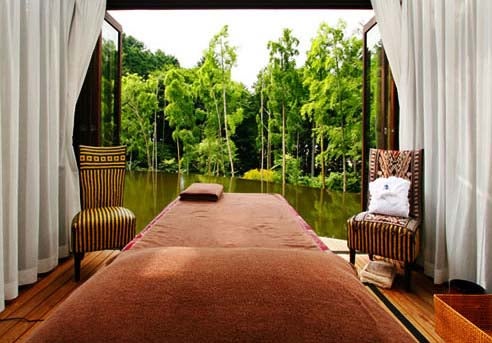Japan's ryokans: inn with the new
For centuries the ryokan was the last word in traditional Japanese hospitality. Now it's getting a boutique makeover and that's shocking the purists, says Kate Graham

Set in a thickly wooded valley, Ginzan is a picture-perfect Japanese town. Snow falls gently on the tiny wooden bridges that cross the gushing river. Old-fashioned gas lamps glow in the early evening darkness, illuminating the cobbled streets and graceful dark-timbered faades along the water's edge. But one building stands out, a stark modern structure of glass and wood that glows from roof to floor like an intricate Japanese lantern. This is Fujiya Ginzan, a building that is helping to redefine the ryokan.
Until recently, Fujiya was as traditional a ryokan as could be found in Japan. This meant tatami matt floors, futon beds and a strict timetable of dining, bathing and curfews. It was a regime passed down within the Fujiya family for hundred of years. Now that Fujiya is gone. Redesigned by the renowned architect Kengo Kuma, it has reopened as an eight-bedroom temple of sleek modernity, natural materials and luxurious Western touches.
Entering through the sliding glass doors, it's clear that the ryokan rulebook has been rewritten. The dramatic full-height lobby feels more art gallery than accommodation, the striking central staircase encased in thousands of vertical lengths of bamboo, and furniture is so scarce there isn't even a reception desk.
There's no public check-in procedure; my bags are simply whisked away and, once my boots have been swapped for buttery soft leather slippers, I am shown to my room. I ascend a staircase that appears to hover and walk down a corridor with walls covered in creamy mottled Japanese paper, everywhere softly lit by recessed floor lamps.
Finally I reach my tatami room with a twist. Instead of woven matting and carpet there are gleaming wooden floorboards and slate. The king-size futon bed is dressed in soft linens and raised on a permanent wooden base. No floor cushions and kneeling are required. A paper door glides open to reveal a sleek dining table and chairs, with views of the rushing river below.
Many traditional ryokan struggle to integrate the new with the old. No such problem here: a rainforest shower and deep cedar tub are part of the open-plan room; the sink is built into the bed's wide headboard. Clever design disguises the functional and ugly; heaters, sockets and toilets are hidden from view. All that's left is a perfectly calm, cream cocoon.
Swapping my clothes for a gorgeous lilac yukata (summer kimono), I sit in the dining room and am served a kaiseki dinner, a gourmet multi-course banquet essential to any ryokan stay. Platters of beautifully presented food keep appearing in the hands of stylishly dressed staff. Sushi and sashimi, nabe stews and pickles, wafer-thin slices of beef and sesame, rice and fruit, all served in delicate china with fresh blossoms for decoration.
After dinner I meet Jeanie, the passionate kimono-clad okami, or general manager, whose family owns and runs the ryokan. Over green tea I learn that while younger guests love the brave design, older people are not so sure. "They have an image of what a Japanese inn should be," she explains. "Then they come here and they think, where am I? They are shocked."
But Japanese lifestyles are changing. Younger couples are having children later and want to use their leisure time to escape the strict social structures that still bind them. "Our typical guests are in their thirties," says Jeanie. "They work hard and want a leisurely, luxurious weekend away. They want privacy and comfort."
Fujiya isn't alone in responding to their demands. In Hakone, the Kinnotake ryokan offers luxurious east-meets-west suites and the chance to sip cocktails until the early hours in its beautiful bar. Tokinoshizuku, also in Hakone, decorates its Japanese rooms with plush rugs and Italian leather furniture as well as offering a cigar bar and aromatherapy salon. And the luxurious boutique Arcana Hotel built on the site of an old Izu ryokan, south-west of Tokyo, is now booked months in advance.
Fujiya's redesign was as much about service as style. So out went the strict timetables and the set menus, as growing numbers of Japanese guests have allergies or food preferences that once were unheard of. Out too went standard communal onsen (hot spring baths), separated by the sexes and limited in their opening hours.
In came five beautifully designed private baths for couples to share which are open 24 hours a day. I sampled one at midnight and was not only shown the ropes by a beaming, bowing assistant but was also sure it was cleaned as soon as I shuffled away, lobster pink, on my wooden geta clogs. Next morning I reluctantly relin-quished my yukata and leave the ryokan. As I step out into the snow, I see a couple stop dead in their tracks to gaze through the glass. They say time moves slowly in Ginzan, but I know I'm not the only one who is glad that's not true.
How to get there:
Bullet trains from Tokyo to Oishida take three hours 20 minutes, price 23,280 yen (104) return. Contact the Japan Travel Bureau (020-7808 3160).
Fujiya can arrange taxi transfers for the 30-minute trip to Ginzan for 5,000 yen (22) each way.
One night's b&b at Fujiya Ginzan (00 81 237 28 2141; fujiya-ginzan.com) costs from 34,800 yen (155) per person.
further information
Kinnotake ryokan (kinnotake.com); Tokinoshizuku ryokan (tokinoshizuku. com); Arcana Hotel (arcanaresorts.com).
Japan National Tourist Organisation (020-7734 9638; seejapan.co.uk).
Further reading: 'Japan Finest Traditional Inns', by Elizabeth Heilman Brooke, will be published by Tuttle on 31 December
Subscribe to Independent Premium to bookmark this article
Want to bookmark your favourite articles and stories to read or reference later? Start your Independent Premium subscription today.

Join our commenting forum
Join thought-provoking conversations, follow other Independent readers and see their replies